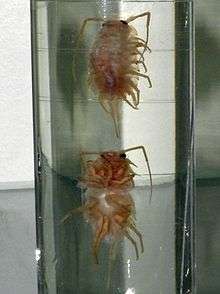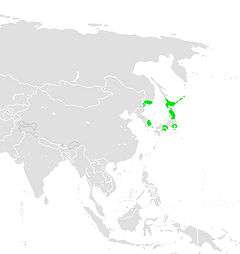Ligia cinerascens
Ligia cinerascens is a woodlouse in the family Ligiidae.[1]
| Ligia cinerascens | |
|---|---|
 | |
| Scientific classification | |
| Kingdom: | |
| Phylum: | |
| Subphylum: | |
| Class: | |
| Order: | |
| Family: | |
| Genus: | |
| Species: | L. cinerascens |
| Binomial name | |
| Ligia cinerascens Budde-Lund, 1885 | |
 | |
| Distribution of L. cinerascens based on available literature | |
Description
L. cinerascens is very similar to L. occidentalis with more antenna segments but shorter overall antenna length.[2] It can be distinguished from L. exotica by its shorter antennae and uropods, as well as its uniformly gray color and granular texture.[3] The species name cinerascens comes from the Latin for "ashy," referring to the gray color of this species.
Life Cycle
In the wild, L. cinerascens usually lives about 1 year (overwintering once) but occasionally lives up to 2.5 years (overwintering twice). Females breed in their first year for five months, then die before the second winter, typically producing one brood - two at the most. Reared in the lab, L. cinerascens has a longer lifespan and may produce 3 or more broods in a lifetime.[4]
L. cinerascens are parasitized by Thinoseius setifer, a mite attaching to the ligia's pleopods.[5]
Distribution
G. H. A. Budde-Lund found samples of L. cinerascens on a long ocean exploration, and when he returned he couldn't remember if they had come from Japan, Manila or Chile, limiting our current knowledge of the full range of the species.[3] It has also been found on Kuril Islands (specifically Kunashir Island) and Peter the Great Gulf in far western Russia.[6] It is one of four ligia species to be found on Japanese coasts. Specifically, it is found mainly on Hokkaido, with a separate population in Tokyo Bay.[4]
References
- Marilyn Schotte (2010). Schotte M, Boyko CB, Bruce NL, Poore GC, Taiti S, Wilson GD (eds.). "Ligia cinerascens Budde-Lund, 1885". World Marine, Freshwater and Terrestrial Isopod Crustaceans database. World Register of Marine Species. Retrieved July 25, 2012.
- Harold Gordon Jackson (1833). "A revision of the isopod genus Ligia (Fabricius)". Proceedings of the Zoological Society of London. 1922 (3): 683–703. doi:10.1111/j.1096-3642.1922.tb02164.x.
- Harriet Richardson (1910). "Isopods collected in the northwest Pacific by the U. S. Bureau of Fisheries steamer "Albatross" in 1906". Proceedings of the United States National Museum. 37: 75–129. doi:10.5479/si.00963801.37-1701.75.
- Toshio Furota; Takeshi Ito (1999). "Life Cycle and Environmentally Induced Semelparity in the Shore Isopod Ligia cinerascens (Ligiidae) on a Cobble Shore along Tokyo Bay, Central Japan". Journal of Crustacean Biology. 19 (4): 752–761. doi:10.2307/1549299.
- Takaku, Gen (2000). "Two new mite species of the genus Thinoseius (Acari: Gamasida: Eviphididae) from Japan". Species diversity. 5: 361–374.
- Lev Aleksandrovich Zenkevich (1963). Biology of the seas of the U.S.S.R. Interscience Publishers. Translated by S. Botcharskaya. p. 768.